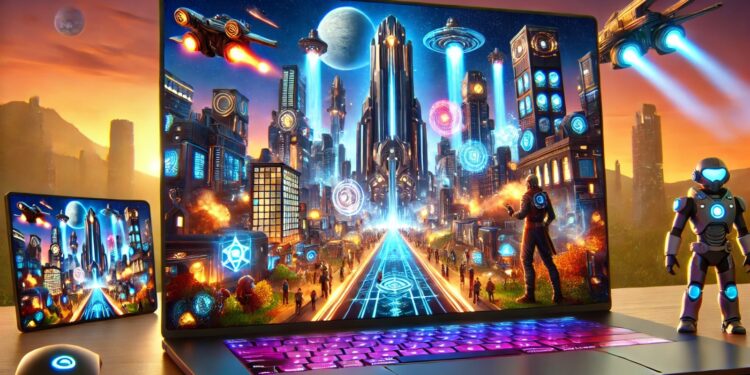Interactive gaming has progressed in the last few years out of which Augmented Reality leads. Games Prediction sources have been developed for the year 2025 due toi different platforms some of which includes Unity that’s easy to use. In terms of performance, an active forum and frequent updates, that challenge existing capabilities of augmented reality game creation, Unity continues to be the go-to platform for developers.
In this tutorial, we will discuss some of the new approaches to using Unity in AR games, features and tools which have made it popular with developers, and some of the trends that will impact augmented reality gaming moving forward. At the end of the sections of this lesson, you shall be in a position to understand how Unity can help you in implementing your idea in augmented reality games.
Why Augmented Reality Games Are Thriving
Augmented interactive games that combine the real environment with that of a computer-generated environment are augmented reality games. Such games are Pokémon GO and Minecraft earth which demonstrate that AR can reach popularity, a mass level, across the globe. Summarized below are the reasons why AR gaming is growing so fast:
- Immersive Experiences: AR games overlay digital elements onto the real world, and this creates quite unique and interactive gameplay.
- Advancements in Technology: Smartphones in particular and other related AR devices such as AR glasses have greatly extended the possibilities of AR experiences.
- Accessibility: By the courtesy of the existing platforms including Unity; both small independent teams and the large studios are developing the AR games way more comfortably.
Unity still dominates the field of AR development, and there are a great deal of new features that it brought in 2025.
1. AR Foundation Enhancement
The AR Foundation is a Unity Package required to build cross-platform on augmented reality applications. As of 2025, it has substantially upgraded as follows:
- Better Cross-Platform Support: AR games can be provided from the android+iOS platforms, but the supply of novel fresh AR glasses should be possible with developers.
- Better Object Recognition: For sake of creating interaction in the game scenes ,it enhances the speed and accuracy of detecting objects.
- Advanced Occlusion Features: More real-time interaction between virtual and existing objects will be observed by the players.
2. AI-Powered Tools
Due to some of these tools, the development of AR games has been eased through incorporation into Unity. Procedural content generation alongside other aspects such as adaptive gameplay help make AR fun and easy to develop with the intelligence support of the AI.
3. Improved Unity MARS
Unity MARS, which stands for Mixed and Augmented Reality Studio, has become more intuitive in 2025. Developers can:
- AR should allow designers to define context-aware experiences intuitively
- Play test AR games in a real environment right within the editor
- New templates and presets? Start now faster
4. Performance with DOTS
DOTS is how Unity refers to this method of building AR games that maintain performance on even the oldest of devices. By now during the year 2025, optimizations have been so fine tuned that the developers would be able to work on even more complex environment and interactions in the game and also do not lose the performance of the DOTS .
5. Integration with Wearable AR Devices
Eyewear AR glass and wearable device represent new gaming paradigms that are also portable. Regarding Unity, the updates for 2025 are direct connection with typical hardware for AR, so gamers will be able to create outstanding games for these platforms easily.
Tips for Creating a Successful AR Game with Unity
Here are some pointers for making your project stand out in case you have plans to design an augmented reality game in 2025:
- Emphasis on Interactivity: Players love games that enable them to interact meaningfully with their surroundings. Make it lifelike and engaging using Unity’s powerful tools.
- Performance Optimization: People do not always get to use the most modern of devices. To ensure that your game seems efficient in the various systems or platforms you intend to use, use the profiling tools of Unity.
- Use Real-World Context: AR games work well when integrated with the real world. Using Unity MARS can help design context-aware gameplay that changes to suit players’ environments.
- Keep It Accessible: AR glasses are on the rise, but most people still use mobile devices to play. Your game should also shine on smartphones.
- Test Thoroughly: With simulation tools, test your game under various environmental conditions and scenarios with Unity, thereby giving you a great polish in your final product.
Trends Influencing AR Game Development in 2025
- Social AR Gaming: Today, there are even more complex multiplayer AR applications with the ability to connect to compete concisely in augmented spaces.
- AR eSports: This competitive gaming trend is on the right path in AR, and more so games based on Unity are popular right now.
- Wearable Integration: As AR glasses become mainstream, games developed for these devices are going to rule.
- Location-Based AR Experiences: Location-based games have become extremely popular, and more than ever, they provide the experience based on where players are.
- AI-Driven Personalization: The personalized experience in AR games has been possible only because of AI, based on individual player preferences and behavior.
The whole AR game development has been really enticing with what Unity provided in the year 2025. Whether you are a lone wolf or as part of a giant company, Unity will have tools and services that will help you get your ideas for the AR games of the future. Therefore, jump right into it, and let your imagination alter realism!
























































